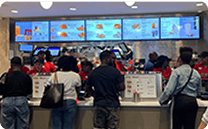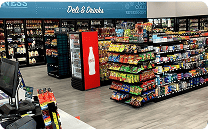In This article
Your customers may love your business and brand, but they dislike waiting. Delivering swift and efficient service is more than convenience. It’s a critical component of customer satisfaction and your business’s success.
Customers expect their interactions with your business to be timely and seamless. Speed of service is a key competitive differentiator, especially in highly competitive markets. Optimizing service speed enhances the customer experience and streamlines your operations, making your business more efficient and profitable. This post details the importance of speed of service, identifies key obstacles, and offers some specific recommendations to help you improve this critical metric.
Why Speed of Service Matters
How fast you can deliver services to your customers can significantly influence customer retention and brand reputation. A survey revealed that 69% of consumers judge the quality of their shopping experience based on whether they receive a “quick resolution.” More than a quarter of those surveyed (27%) said they were more likely to spend money when a brand responds faster than expected.
However, the quality of each shopper’s journey is at least as important as the speed of each transaction. Rushed processes sacrificing accuracy or personalization can lead to errors and customer dissatisfaction. Your business cannot compromise the integrity of the services you deliver to maximize your speed of service.
Identifying Bottlenecks to Improve Service Speed
Several obstacles can challenge or hobble even the most well-thought-out rapid service strategies. Here are three of the most common.
- Inefficient Workflows: Complex or outdated procedures can slow operations, increase costs, and disappoint customers.
- Understaffing: Too few or inadequately trained personnel can lead to longer wait times for your customers and overburdened employees. Without the proper expertise and support, your employees face burnout, and your business can face greater recruitment costs and challenges.
- Outdated Technology: Obsolete systems can make swift service delivery difficult or impossible. If your business relies upon delivery to or consumption of services from government agencies, inefficient bureaucracy and poor accountability can add to the delays and disappointments caused by out-of-date technologies.
To identify and address these bottlenecks, your business should seek, collect, analyze, and respond to customer feedback regularly and frequently, and conduct thorough operational analyses periodically. Process mapping and management tools can help you and your colleagues visualize your workflows and pinpoint delay-causing problem areas.
Strategies for Improving Speed of Service
To effectively address the challenges to your service speed optimization efforts, you must take and coordinate multiple steps. Here are some options you should put at or near the top of your to-do list.
Technology Integration
- Digital Kiosks and Self-Service Options: Implementing self-service kiosks can reduce wait times and empower customers to complete transactions independently. For example, McDonald’s QSR restaurants have introduced digital kiosks that accept cash and return change, streamlining the ordering process. However, you must combine these technologies with rapid access to employees with the skills needed to help users resolve or escalate problems quickly.
- Mobile Ordering and Automation: Mobile ordering apps and integrating automation into your service processes can streamline operations and reduce human error. The automation provided by self-service kiosks and advanced payment systems helps minimize human error, resulting in a 20% decrease in order inaccuracies.
Employee Training
- Efficiency Through Training: Well-trained staff can perform tasks more quickly and accurately, enhancing service speed and customer experiences. Representatives knowledgeable about your offerings and services can promptly provide customers with the answers they need and the care they expect.
- Streamlined Processes: Training programs should focus on how efficient workflows and effective technology implementations can directly enable faster service delivery.
Queue Management
- Optimizing Customer Flow: Queue management systems can help organize customer flow, reduce perceived wait times, and improve the overall in-store experience. Optimized customer flows enabled by signs and displays that make your store easy to navigate can help your team manage customer requests more efficiently and increase operational efficiency and service quality.
- Self-Service Options: Apps and online portals that offer self-service account management, appointment scheduling, check-ins, or other features can expedite processes and reduce congestion and delays.
Optimizing Service Time with Process Improvements
You must assess and improve critical business processes to optimize service delivery speed effectively and consistently. Here are some recommendations that can help.
- Lean Management Techniques: Lean management focuses on five areas: defining value, mapping the value stream, creating flow, establishing a pull system, and pursuing perfection through continuous improvement. Applying lean principles can help eliminate waste and streamline processes, leading to faster service. In quick service restaurants, for example, lean management implementations have reduced waiting times and increased satisfaction.
- Enhanced Team Communication: Improved communication channels within your business can lead to better coordination, faster service delivery, and problem resolution. Modern collaboration tools can help here if they are implemented with adequate training and support.
Rapid Service Strategies for Different Sectors
Increased speed of service can benefit customers and businesses in any industry, such as a QSR restaurant, retail operation, or healthcare, where quick service is imperative. Here are some examples.
Retail
- Self-Checkouts: Self-checkout stations can expedite purchasing if implemented with adequately trained support staff and easy access and navigation features. Modern self-checkout systems offer AI-powered instant support via helpful prompts and guidance through the system interface.
- Automated Inventory Tracking: Effective inventory management ensures products are readily available, reducing delivery and fulfillment delays. For example, an inventory management system can automatically tell a shopper that the store closest to them has a desired item in stock. Popular clothing retailer Old Navy has introduced RADAR, a high-tech system combining AI, computer vision, and radio frequency identification (RFID) technologies to enable real-time inventory tracking.
- AI-Driven Customer Assistance: AI chatbots can provide accurate, easily scalable, readily updated, and instant support and information to customers.
Quick Service Restaurants (QSR) Food & Beverage
- Mobile Pre-Ordering and Payments: Mobile apps and online portals that enable customers to order and pay before arriving at a fast service restaurant can reduce wait times and speed fulfillment. Real-time order tracking enhances transparency and customer satisfaction.
- Drive-Through Optimizations: Drive-through support platforms increasingly include AI and automation features that can enhance speed and accuracy for staff and customers and improve the efficiency of a QSR business.
Healthcare
- Digital Appointment Booking: Online scheduling systems can streamline patient appointments and reduce administrative burdens. Digital patient check-in solutions have improved patient satisfaction and operational efficiency.
- Automated Check-Ins: Self-service kiosks for patient check-ins can expedite registration.
- Improved Patient Flow: Applying lean management strategies can enhance patient throughput and reduce waiting times.
Measuring Success and Continuous Improvement
Improving the speed of service at your business is not a “one-and-done” project. Instead, it is a continuous, cyclical process of measurement, feedback, refinement, and updated measurement. To ensure your speed enhancement strategies are working, you must define and track relevant key performance indicators (KPIs) and establish and nurture a culture that values ongoing improvement.
Key KPIs to Track
- Service Time: How long does it take from the moment a customer initiates a request to its resolution? This includes wait times, transaction completion times, and average handling times (AHT). Automation and AI features can ease and speed the process of collecting relevant data and turning it into actionable information.
- Customer Satisfaction (CSAT) and Net Promoter Score (NPS): Use short post-service surveys and feedback prompts to gauge how customers perceive the speed and quality of their experiences. Report and share the results of these efforts with staffers to improve customer care and with managers to improve strategic business decisions.
- Operational Efficiency Metrics: These include employee productivity, task completion times, queue abandonment rates, and both planned and unplanned system downtime periods. These metrics reflect how efficiently your internal operations and systems support and sustain service speed optimization.
- First Response and Resolution Times: These metrics focus on quickly identifying, acknowledging, and resolving customer issues. They are critical for accurately assessing your service speed enhancement and overall customer care efforts.
Regular Audits and Data-Driven Refinement
Regular service audits can help you and your colleagues identify performance gaps and systemic inefficiencies. These audits can be conducted via mystery shopping, workflow analysis, or technology performance reviews. Findings can help you to align staffing more closely to demand peaks and lulls, and to identify and refine or replace delay-causing platforms, processes, or tools
Modern technologies can make audits and leverage audit data faster and more productively. Platforms such as Yellow.ai, for example, emphasize using intelligent automation and AI to continuously analyze customer interactions and flag drops in speed of service or customer satisfaction. Tools such as OvationCXM and NICE CXone can enable the creation and sharing of real-time dashboards and automated reports. These can help managers quickly identify and address bottlenecks before affecting customer experiences and satisfaction.
Creating a Culture of Continuous Improvement
Successful rapid service strategies are about more than systems and processes. Optimizing the speed of service is also about the mindset of those responsible for delivering your offerings and the best possible customer experiences. Here are some suggestions to help you encourage a culture where staff are empowered to suggest improvements and feel ownership of service outcomes and customer experiences.
- Create feedback loops: Ask customers and employees for input on improving service speed and delivery. Request, encourage, and share promising suggestions and success stories to encourage further engagement.
- Incentivize performance: Recognize and reward employees who consistently meet or exceed service benchmarks. Encourage them to share tips for success with their colleagues.
- Review, refine, and repeat: Use customer journey mapping, CSAT survey results, and other relevant input and feedback to regularly review and optimize every element of service delivery and customer care. Numerous vendor and industry analyst research reports have found that businesses that create seamless, frictionless customer experiences across departments see higher customer retention and loyalty.
Continuously refine your service delivery and customer care strategies based on the best available data, insights, and frontline feedback. This will keep your business agile and resilient in the face of constant changes in market forces and customer preferences.
Conclusion
Speed of service is one of the most critical elements of your customers’ experiences and satisfaction with your business. Expectations of near-instant gratification created by tech giants and online shopping options mean your business must consistently deliver fast, frictionless, and high-quality service and customer care.
By adopting a data-driven approach and investing in speed-enhancing solutions, your business can foster stronger customer relationships, increase operational efficiency, and boost its bottom line now and in the long term. To learn more about DTiQ’s speed of service solutions, visit our website.
Meta description for WP
Discover strategies to enhance speed of service and deliver faster, more efficient customer experiences. Learn how technology, training, and process improvements can boost satisfaction and drive business success.























